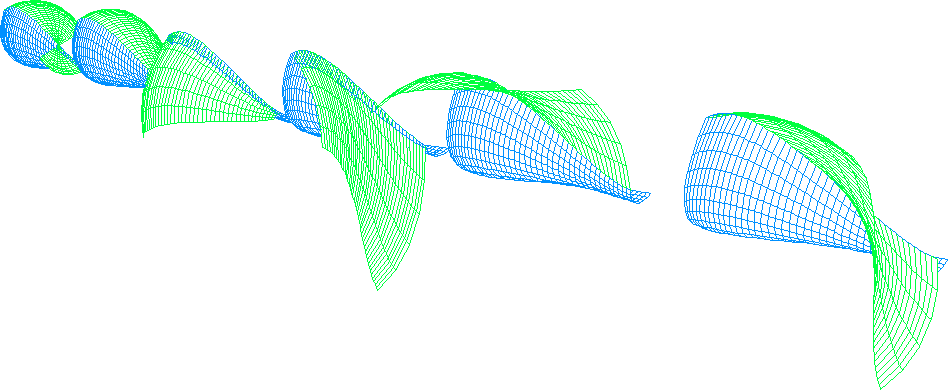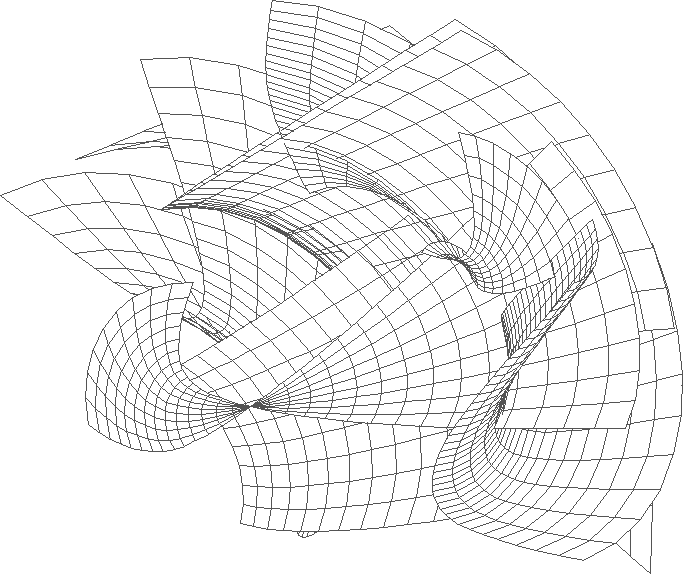2002.07.11 11:40
Re: Parametric Design
I have used parametric tools, and I know how to use them passively and actively.
For the record, I'm utilizing to term 'parametric tools' to describe those computer aided functions / commands that require usually a set of parameters to be input for the command to follow through. For example, a rotate and extrude command needs:
1. a predrawn line formation that is to be rotated and extruded--the profile of a vase, for example.
2. two points to designate the axis around which the line formation is to be rotated, usually parallel to the profile.
3. various variables must be decided upon, e.g., how many facets should the extrusion manifest as it rotates around the axis? should the extrusion do a full 360 degrees or less?
The interesting, though not taught, part of all this is that just by slightly (or greatly) changing the angle of the axis of rotation, an entirely unpredictable extruded form will result. It is this unpredictability of what is essentially an infinite amount of possibilities that computer aided design really engenders. Only by being arbitrary with the parameters does one begin to see what all possibilities really means, or at least look like.
This is a somewhat difficult to describe with just a few words. A full demonstration with many diagrams and steps is really required. Nonetheless, look at the images within wqc/dossiers/surfaces. These images are the results of where arbitrary portions of 3-d spline lines are rotated (mostly 45 degrees) and extruded around an arbitrarily chosen axis. It is only after having done many such experiments (and being arbitrary allows for many, many quickly executed experiments) that I have begun to use this command arbitrarily but with some predictability. Essentially, I now know what some of the parameters are likely to engender.
If you think about it, the process I followed is really neither purely active or passive. I was not a slave to the programming, nor to the notion of 'finding' the right parameters for the right result. I also didn't bring any preconceived ideas to the program (such as drawing the axis of rotation always parallel to the profile). I 'played' it.
2002.07.14 15:00
Re: Parametric Design
Just some running thoughts:
The way one thinks influencing the way one uses tools is probably better than the way one uses tools influencing the way one thinks.
[For me,] 2D CAD and 3D CAD are the same thing in that both 'drawings' are executed within a 3D CAD environment. I view the data within the CAD environment different than the data as it is output, (eg, as CAM or as a print), because data within the CAD environment is always fluid.
I have often 'played' with changing the x,y,z parameters of existing CAD models. It is very easy to change the Villa Savoye, for instance, by x factor of 2, a y factor of .5 and a z factor of 3--this will make the Villa Savoye twice as long, half as wide, and 3 times as high. And if you incorporate an angle change(s) along any or all of the x, y, or z axes, then the resultant model gets very bizarre.
I utilize parametric design capabilities to investigate what modes of 'drawing' are at my disposal--it is 'playing' to learn and observe rather than just to entertain (myself).
The biggest drawback of CAD versus hand-drawing is the cost of CAD software (and also hardware). CAD is usually only something that can be used 'at the office.' It is unfortunate that not everyone has the chance to 'experiment' with CAD outside of the 'billable' work environment. Even students are limited in the amount of free experimentation they can perform, mostly due to project deadlines.
The biggest advantage of CAD over hand-drawing is that CAD generates digital data, and it is indeed the digital property of CAD data that make the data so usable (ultimately to CAM) and malleable (via variable parameters).
I never play with 'original' data, rather I play with copies of the original data.
| |
2012.05.22 09:41
the ethics of parametricism/emergent architectural thought and reification
Let me add another facet (writing here on the fly, so it may not be all too coherent). Besides the mimicry of a myth (so to speak), is not the whole process of getting the 'code' just the way you want it--the continual tests and retests--also something like an inverted (if you will) form of mimicry: "I know what I want it to look like; I just have to find the right parameters." Or, put in a way (hopefully) like above: "I know what nature I want it to look like, but I still have to figure out the right numbers."
In the little bit of parametrics I've dabbled with, using very old (1996) software, I found that using "numbers" that were outside the 'expected' parameters resulted in the most 'novel' results.

A very early example of the 'playing', 2000.
Does it still just boil down to a sophisticated play of/with geometry?

And adding the 'unexpected' thinking, imagine the image above as the 2-dimentional 'grid' plan of a city. It's like actually stepping out of the mimicry.
|